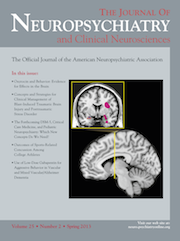Progressive Impairment of Decision-Making in Behavioral-Variant Frontotemporal Dementia
To the Editor: Behavioral-variant frontotemporal dementia (bvFTD) is characterized by marked alterations in behavior, personality, and social conduct, related to metabolic alterations of the medial prefrontal cortex (mPFC).1 In early bvFTD, patients may show preserved performance in traditional executive tasks,2 while presenting early impaired performance on the Iowa Gambling Task, (IGT), which assesses decision-making under ambiguous conditions and taps mPFC functions.3 Although the progressive prefrontal neurodegeneration has been seen, no studies assessed the progression of decision-making impairment in bvFTD. We hypothesized that decision-making may worsen along the course of bvFTD, and, to test this hypothesis, we longitudinally assessed two bvFTD patients, matched with 10 healthy controls (HC).
“MM” was a 49-year-old woman, working as doorperson. She presented a pattern of behavioral alterations (apathy, decline in personal hygiene, bizarre behaviors) and cognitive impairment involving executive functions and visuospatial functions. SPECT showed hypoperfusion in the right fronto-parieto-temporal cortex and in the left superior gyrus; 18FFDG PET showed a bilateral extended reduction of the glucose metabolism in the frontal, prefrontal, temporal, posterior parietal, and occipito-parietal areas.
“MS” was a 56-year-old engineer. He presented a pattern of behavioral alterations (marked apathy, difficulties at work, aggressiveness) and cognitive impairment involving executive functions and episodic memory. SPECT showed moderate hypoperfusion in the left temporal and parietal cortices; 18FDG-PET showed an extended area of hypometabolism in the left parieto-temporal cortex, extended to the insula and the hippocampus and in the left infero-mesial frontal gyrus.
Patients MM and MS received a clinical diagnosis of bvFTD. Their executive functioning was followed longitudinally, including decision-making ability, with the IGT, whose quantitative parameter consists of the net number of advantageous choices computed for the whole set of 100 cards.
Patients attained these IGT scores: MM: −10 (baseline), −18 (5 months after baseline); MS: 0 (baseline), −2 (11 months after baseline), −14 (20 months after baseline). The mean total IGT score of HCs was 6.08 (SD: 6.82). Adopting a Bayesian inferential method,4 results showed that, compared with HCs, all IGT performances of MM were significantly lower (p<0.01), whereas only the third IGT performance of MS was significantly lower (p<0.05).
IGT performances of these patients globally suggest that decision-making may worsen along the course of bvFTD, confirming our hypothesis. Worsening of decision-making occurred with a general worsening of executive functioning, suggesting that these two phenomena could be somehow related. However, IGT accounts for variance in decision-making performance not currently attributable to classic measures of executive functioning;5 therefore, the longitudinal worsening of performances in a task that principally taps mPFC functions (IGT) and in tasks that principally tap dorsolateral PFC functions (other executive tasks) is probably more due to a progressive neurodegeneration affecting both these prefrontal regions than to the reciprocal influence between these different prefrontal functions.
This study suggests that the IGT is a useful neuropsychological tool for detecting earliest signs of cognitive impairment and then its worsening in bvFTD patients.
1 : Apathy and disinhibition in frontotemporal dementia: insights into their neural correlates. Neurology 2008; 71:736–742Crossref, Medline, Google Scholar
2 : Executive function in progressive and nonprogressive behavioral variant frontotemporal dementia. Neurology 2008; 71:1481–1488Crossref, Medline, Google Scholar
3 : The relation between affective decision-making and theory of mind in frontotemporal dementia. Neuropsychologia 2007; 45:342–349Crossref, Medline, Google Scholar
4 : Comparison of a single case to a control or normative sample in neuropsychology: development of a Bayesian approach. Cogn Neuropsychol 2007; 24:343–372Crossref, Medline, Google Scholar
5 : Decision-making and cognitive abilities: a review of associations between Iowa Gambling Task performance, executive functions, and intelligence. Clin Psychol Rev 2010; 30:562–581Crossref, Medline, Google Scholar



